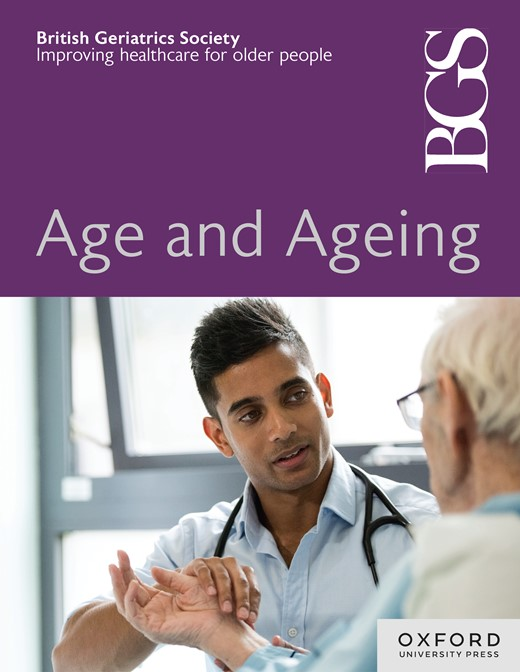Work of ART: Profiling the First 100 Patients Discharged Home From an Acute Hospital with the Active Recovery Team (ART)
IF 6
2区 医学
Q1 GERIATRICS & GERONTOLOGY
引用次数: 0
Abstract
Background The Active Recovery Team (ART) is a new therapy lead rehabilitation team that offers supported discharge and admission avoidance from a large acute hospital. This interdisciplinary team consists of a physiotherapist, occupational therapist, medical social worker and two therapy assistants. ART accepts referrals from all services within the hospital including the emergency department. Methods As ART is a new service, a retrospective audit of the first 100 patients who discharged on the pathway was completed. Demographics included age, sex, referring specialty, presenting complaint, frailty (measured by the Clinical Frailty Score) and level of input received. ART use the coding of low, medium and high intensity to describe the intervention provided based on dosage (visits) and complexity. Results Most (67%) of the group were female and mean age was 77 years. Only 8% were pre-frail (CFS 0-3), 86% were living with mild to moderate frailty (CFS 4-6) and 6% considered severely frail (CFS 7-9). The type of intervention patients received was 31% low, 33% medium and 36% high intensity. Referrals came from a range of specialties, but the highest percentage of referrals were from emergency medicine (29%), medicine (20%), orthopaedics (18%) and geriatric medicine (16%). Most (53%) initially presented post a fall at home. Most frequent reason for ART referral (78%) was that the patient was discharging home not at their functional baseline but had potential to an achieve a specific goal(s) with further input (most frequently within domains of mobility indoors/outdoors, transfers, stairs and activities of daily living). Conclusion This is an effective pathway that improves the transition from hospital to home. ART offer patients an opportunity for further rehabilitation at home with continuity of care from the acute hospital. Future work will examine the impact of ART on length of stay, readmission rate and explore patient satisfaction with this service.ART 的工作:剖析在积极康复团队(ART)的帮助下从急症医院出院回家的前 100 名患者
背景 积极康复团队(ART)是一个新成立的以治疗为主导的康复团队,为一家大型急症医院的病人提供支持性出院服务,避免病人入院。该跨学科团队由一名物理治疗师、一名职业治疗师、一名医务社工和两名治疗助理组成。ART 接受医院内包括急诊科在内的所有服务部门的转介。由于 ART 是一项新服务,因此我们对前 100 名通过该路径出院的患者进行了回顾性审核。人口统计学数据包括年龄、性别、转诊科室、主诉、体弱程度(以临床体弱程度评分法衡量)和所接受投入的水平。ART 采用低、中、高强度编码,根据剂量(人次)和复杂程度来描述所提供的干预。结果 小组中大多数(67%)为女性,平均年龄为 77 岁。只有 8% 的患者属于前期虚弱(CFS 0-3),86% 的患者属于轻度至中度虚弱(CFS 4-6),6% 的患者属于严重虚弱(CFS 7-9)。患者接受的干预类型中,31%为低强度,33%为中强度,36%为高强度。转诊患者来自各个专科,但转诊比例最高的是急诊科(29%)、内科(20%)、骨科(18%)和老年医学科(16%)。大多数患者(53%)最初是在家中摔倒后就诊。转介 ART 的最常见原因(78%)是患者出院回家时功能未达到基线,但有潜力通过进一步治疗实现特定目标(最常见的领域包括室内/室外活动能力、转移、爬楼梯和日常生活活动)。结论 这是一条有效的康复途径,可以改善从医院到家庭的过渡。ART 为患者提供了在家中接受进一步康复治疗的机会,并保持了急症医院护理的连续性。未来的工作将研究 ART 对住院时间、再入院率的影响,并探讨患者对这项服务的满意度。
本文章由计算机程序翻译,如有差异,请以英文原文为准。
求助全文
约1分钟内获得全文
求助全文
来源期刊

Age and ageing
医学-老年医学
CiteScore
9.20
自引率
6.00%
发文量
796
审稿时长
4-8 weeks
期刊介绍:
Age and Ageing is an international journal publishing refereed original articles and commissioned reviews on geriatric medicine and gerontology. Its range includes research on ageing and clinical, epidemiological, and psychological aspects of later life.
 求助内容:
求助内容: 应助结果提醒方式:
应助结果提醒方式:


